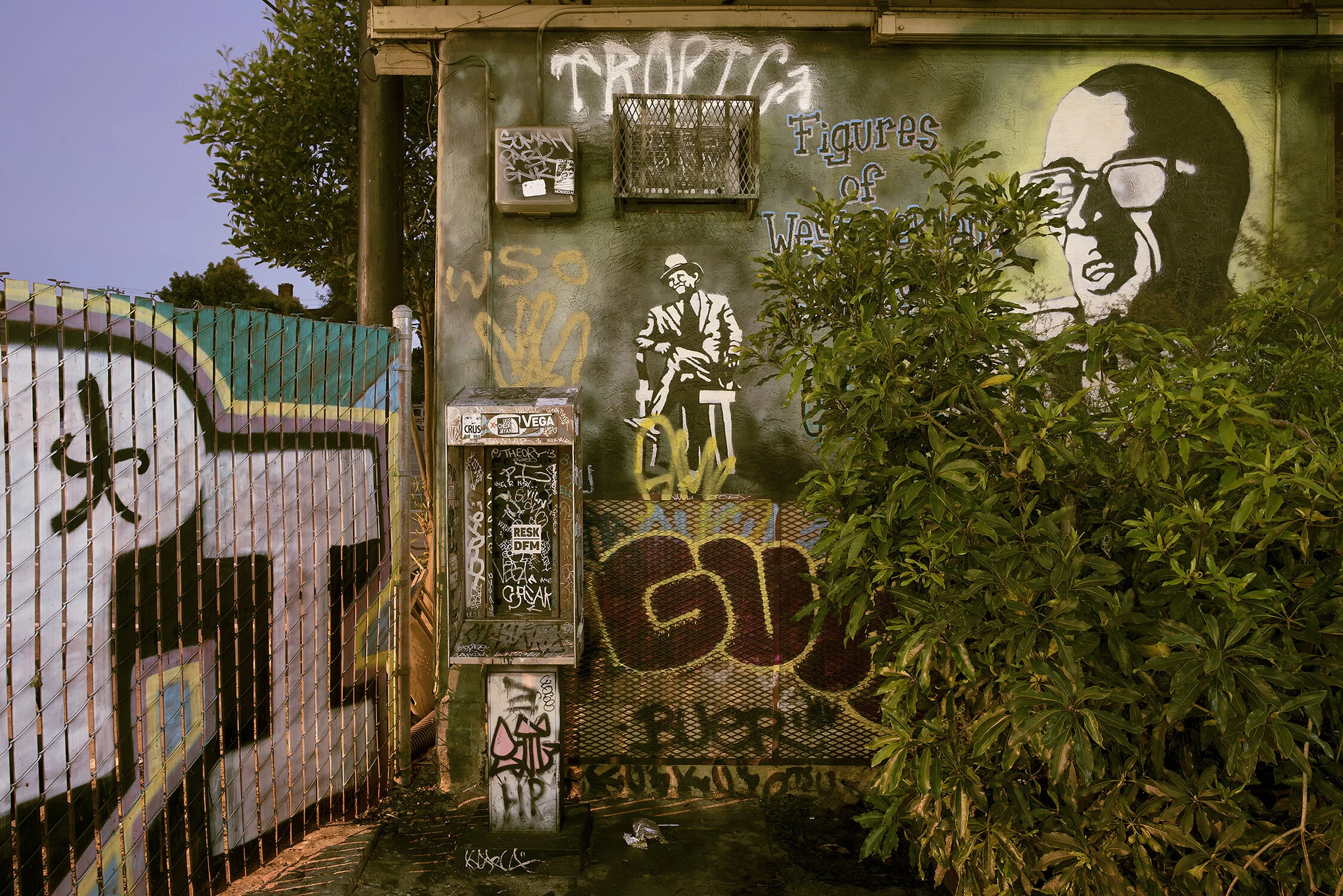UNDER THE OVERPASS
These photographs explore the intersection of art and life on the streets of Oakland—not the leafy terraces with their pricey views curving around the hills, but the sun-baked, ramrod-straight avenues below that comprise the neighborhoods of Dog Patch, Lower Bottoms, Desert Yard, Chinatown, Ghost Town, Jingletown, Deep East, and The Twomps.
Here, curbside memorials, corner bodegas with plywood windows, and sprawling tent cities beneath overpasses fill this gritty urban grid. And then there is the street art. Few surfaces go untouched. Towering murals—some commissioned, most not—claim the largest expanses, while graffiti battles for the remaining scraps. Murals are often communal creations, rich with cultural and historical significance that honor their neighborhoods. Graffiti, in contrast, is usually word-based, the mark of individuals. Many local merchants and residents despise it; others see its vibrant artistry, and some embrace it as a weapon against gentrification. This guerrilla art is sprayed onto walls nightly.
+ MORE INFO
It wasn’t unusual to photograph a wall one morning, only to return the next day and find it completely transformed, fresh graffiti still sticky under the sun. I came to suspect that for these dueling street artists—many homeless and struggling—the act of acquiring paint and applying it to walls is not a luxury but a vital necessity. The more transient and fragile their existence, the greater their need to leave a permanent, indelible mark.
Over four years, I spent three mornings a week photographing these artists’ work, though I saw only four at the act itself. By dawn, they had vanished. But I often encountered the people living in Oakland’s growing tent communities, always striving to respect their space. I asked permission before photographing and, whenever possible, kept people out of my frame. When asked why I photographed, I said I was moved by the beauty and power of the art on the walls—an answer that often resonated. The art spoke to them as much as they spoke to it. Many knew the artists and took pride in the work as if it were their own, which in a way, it was. The graffiti and murals on the dusty, oil-stained walls were the last images of the outside world these residents carried inside as they zipped up their tents each night.
No matter where we find ourselves—urban or isolated—nature is never far. It reveals itself more subtly in Oakland’s urban wilds than in the mountains, deserts, and seascapes I’ve often photographed, but it is there. It appears in murals imagining the oak-studded plains of this city before European arrival altered the landscape’s sublime beauty. It is present in the harsh finality of lives cut short, memorialized in countless impromptu sidewalk shrines. It lives in the curvilinear, organic calligraphy of graffiti and the iconic symbols of individual artists. Even the way garbage is scattered and shredded by wind and rain speaks to nature’s presence.
Each night, under cover of darkness, trash is dumped from pickup beds and car trunks until some streets and alleys become impassable. Under streetlights, these scattered heaps resemble river rapids—fast-food wrappers sparkling like white caps. From this unsanitary chaos, the unhoused build their shelters, fashioning homes from the flotsam and jetsam of those better off upstream. Tents designed for pristine wilderness sag in the deep blue dawn beneath overpasses, lined up like opening-day salmon fishers on the Klamath River banks.
These images seek to reconcile the often brutal reality of life on Oakland’s streets with the vivid fictions painted on its walls—revealing a provocative, uncanny relationship between the two. At times, reality and art fuse into a single whole, the street’s call answered by the wall behind it—or perhaps the other way around. The belief that tomorrow will be better—a sentiment scrawled explicitly on one wall and echoed in the fantasies of many others—is embodied in the smile of a woman sweeping the sidewalk before her tent. Nearby, framed paintings she hung on a chain-link fence honor a friend lost to overdose. Encountering such hope amid hardship is humbling—a powerful testament to the resilience of the human spirit.
This Oakland tells its story on its walls. Its symbols are unique, its references local, its warnings tribal. The setting is a modern-day Wild West, neighborhoods barely policed or not at all. In this vacuum, tent cities grow beneath overpasses, walls explode with self-expression, and streets thicken with trash and loss. It’s a ramshackle chaos, yes, but not without beauty. I dedicate these photographs to the restless souls who shake the cans and wield the spray paint.







































































